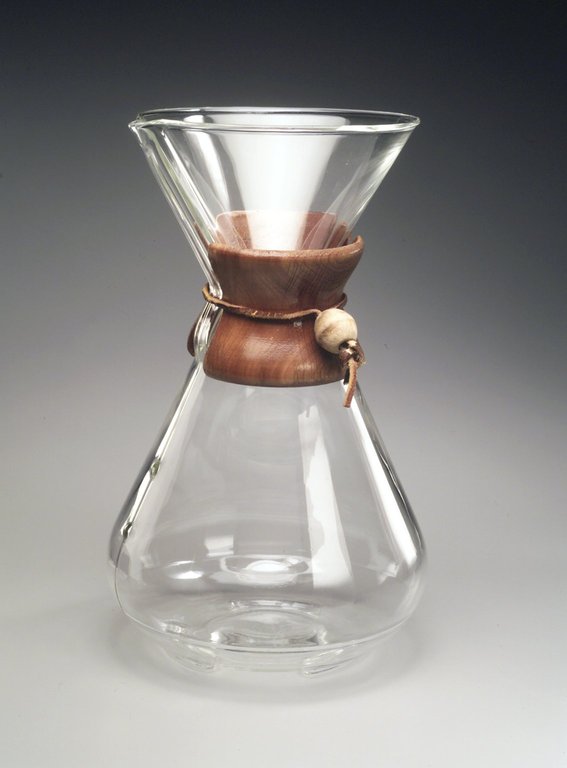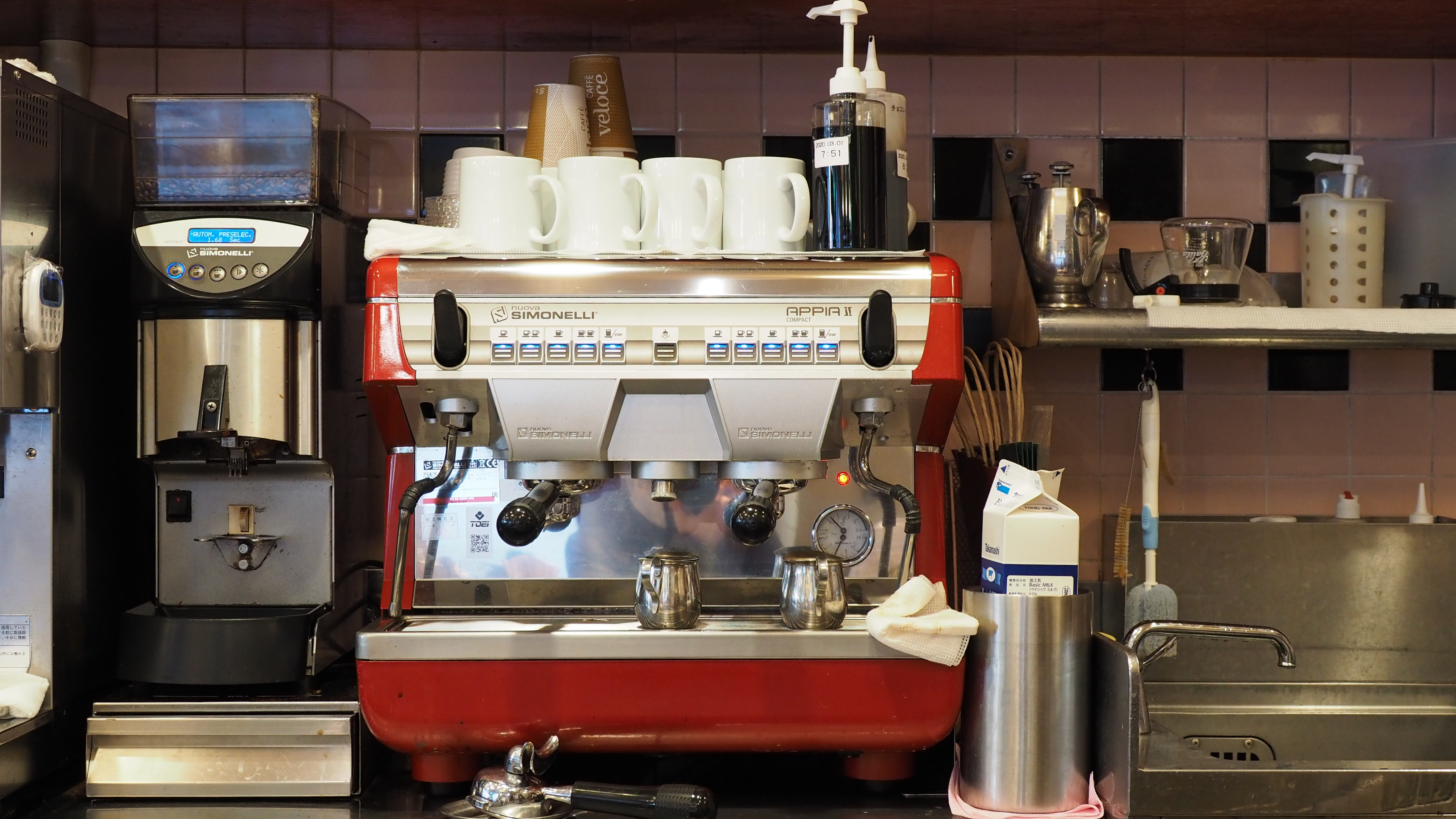|
SoftBrew
Sowden SoftBrew is a coffee brewing device which was invented in Italy in 2010 by designer George Sowden that requires no pressing. Its operates similarly to a Chemex or French Press. Essentially a steeper, that can be used for coffee or tea. The device is sold in different teapots in varying styles, shapes and sizes. The device uses a simple infusion method for brewing coffee. A stainless steel filter with thousands of holes blocks all grounds larger than 150 microns, allowing any grind of coffee to be used, such as fine, medium or coarse. SoftBrew SoftBrew is a method of coffee-making that is very different process than espresso - where water is forced through the group head under pressure. According to Chris White, Director at Altura Coffee Co. in New Zealand, “Soft brew makes it much easier to pick up on the distinct taste characteristics coffee. For example, it’s hard to distinguish between the flavour characteristics of Kenyan and Guatemalan coffee in an espresso †... [...More Info...] [...Related Items...] OR: [Wikipedia] [Google] [Baidu] |
George Sowden
George J. Sowden (born 1942 in Leeds, UK) is a designer and product developer. Career He studied architecture at Gloucestershire College of Art in the 1960s. In 1970, he moved to Milan, where he started working with Ettore Sottsass and Olivetti. In parallel to the industrial design work on early Olivetti computers., he was involved during the 1970s in experimenta"radical" design projectswhich enabled him to become, in 1981, one of the co-founders of the Memphis Group, the design movement that had a significant impact on design in the eighties. In the same year, 1981, he founded his design studio, SowdenDesign, collaborating with companies such as Olivetti, Alessi, Bodum, Guzzini, Lorenz, Rancilio, Steelcase, SwatchSegis Memphis, IPM, Moulinex, Telecom Italia, Tefal and Pyrex. In 1991, Sowden received the Compasso d'Oro Award for design excellence for Olivetti, Fax OFX420. Notable works In 2010, Sowden developed the SoftBrew coffee brewing device, which is distribut ... [...More Info...] [...Related Items...] OR: [Wikipedia] [Google] [Baidu] |
Coffee
Coffee is a drink prepared from roasted coffee beans. Darkly colored, bitter, and slightly acidic, coffee has a stimulant, stimulating effect on humans, primarily due to its caffeine content. It is the most popular hot drink in the world. Seeds of the ''Coffea'' plant's fruits are separated to produce unroasted green coffee beans. The beans are Coffee roasting, roasted and then ground into fine particles that are typically steeped in hot water before being filtered out, producing a cup of coffee. It is usually served hot, although chilled or iced coffee is common. Coffee can be prepared and presented in a variety of ways (e.g., espresso, French press, caffè latte, or already-brewed canned coffee). Sugar, sugar substitutes, milk, and cream are often used to mask the bitter taste or enhance the flavor. Though coffee is now a global commodity, it has a History of coffee, long history tied closely to food traditions around the Red Sea. The earliest credible evidence of coffee d ... [...More Info...] [...Related Items...] OR: [Wikipedia] [Google] [Baidu] |
Italy
Italy ( it, Italia ), officially the Italian Republic, ) or the Republic of Italy, is a country in Southern Europe. It is located in the middle of the Mediterranean Sea, and its territory largely coincides with the homonymous geographical region. Italy is also considered part of Western Europe, and shares land borders with France, Switzerland, Austria, Slovenia and the enclaved microstates of Vatican City and San Marino. It has a territorial exclave in Switzerland, Campione. Italy covers an area of , with a population of over 60 million. It is the third-most populous member state of the European Union, the sixth-most populous country in Europe, and the tenth-largest country in the continent by land area. Italy's capital and largest city is Rome. Italy was the native place of many civilizations such as the Italic peoples and the Etruscans, while due to its central geographic location in Southern Europe and the Mediterranean, the country has also historically been home ... [...More Info...] [...Related Items...] OR: [Wikipedia] [Google] [Baidu] |
Chemex Coffeemaker
The Chemex Coffeemaker is a manual pour-over style glass coffeemaker, invented by Peter Schlumbohm in 1941, manufactured by the Chemex Corporation in Chicopee, Massachusetts. In 1958, designers at the Illinois Institute of Technology said that the Chemex Coffeemaker is "one of the best-designed products of modern times" and it is included in the collection of the Museum of Modern Art in New York City. Design The Chemex coffeemaker consists of an hourglass-shaped glass flask with a conical funnel-like neck and proprietary filters, made of bonded paper, that are thicker than the standard paper filters used for a drip coffeemaker. The thicker paper of the Chemex filters removes most of the coffee oils and makes coffee that is much "cleaner" than coffee brewed in other coffee-making systems. The "cleaner" cup extracts caffeine and flavor while removing bitter notes. The thicker filters may also assist in removing more cafestol Cafestol is a diterpenoid molecule present in coffee ... [...More Info...] [...Related Items...] OR: [Wikipedia] [Google] [Baidu] |
French Press
A French press, also known as a cafetière, ''cafetière à piston'', ''caffettiera a stantuffo'', press pot, coffee press, or coffee plunger, is a coffee brewing device, although it can also be used for other tasks. In 1923 Ugo Paolini, an Italian, filed patent documents relating to a tomato juice separator and he developed the idea of making a coffee pot with a press action and a filter. He assigned his 1928 patent to Italian designer Attilio Calimani and Giulio Moneta who filed it in 1929. Nomenclature In English, the device is known in North America as a ''French press'' or ''coffee press''; in Britain and Ireland as a ''cafetière''; in New Zealand, Australia, and South Africa as a ''coffee plunger'', and coffee brewed in it as ''plunger coffee''. In Italian, it is known as a ; in German as a ' ("stamp pot") or ' ("coffee press"); in French as ', or simply as ' (also the usage in Dutch), though some speakers might also use genericized trademarks, such as Melior or Bodum. ... [...More Info...] [...Related Items...] OR: [Wikipedia] [Google] [Baidu] |
Espresso
Espresso (, ) is a coffee-brewing method of Italian origin, in which a small amount of nearly boiling water (about ) is forced under of pressure through finely-ground coffee beans. Espresso can be made with a wide variety of coffee beans and roast degrees. Espresso is the most common way of making coffee in southern Europe, especially in Italy, France, Spain, and Portugal. It is also popular in Switzerland, Croatia, Bosnia and Herzegovina, Bulgaria, Greece, South Africa, the United Kingdom, the United States, Canada, Australia and New Zealand. Espresso is generally thicker than coffee brewed by other methods, with a viscosity similar to that of warm honey. This is due to the higher concentration of suspended and dissolved solids, and the ''crema'' on top (a foam with a creamy consistency). As a result of the pressurized brewing process, the flavors and chemicals in a typical cup of espresso are very concentrated. Espresso has more caffeine per unit volume than most coffee be ... [...More Info...] [...Related Items...] OR: [Wikipedia] [Google] [Baidu] |
Brewed Coffee
Brewed coffee is made by pouring hot water onto ground coffee beans, then allowing to brew. There are several methods for doing this, including using a filter, a percolator, and a French press. Terms used for the resulting coffee often reflect the method used, such as drip brewed coffee, filtered coffee, pour-over coffee, immersion brewed coffee, or simply coffee. Water seeps through the ground coffee, absorbing its constituent chemical compounds, and then passes through a filter. The used coffee grounds are retained in the filter, while the brewed coffee is collected in a vessel such as a carafe or pot. History Paper coffee filters were invented in Germany by Melitta Bentz in 1908 and are commonly used for drip brew all over the world. In 1954 the Wigomat, invented by Gottlob Widmann, was patented in Germany being the first electrical drip brewer. Drip brew coffee makers replaced the coffee percolator in the 1970s due to the percolators' tendency to over-extract coffee, the ... [...More Info...] [...Related Items...] OR: [Wikipedia] [Google] [Baidu] |


.jpg)

_coffee.jpg)